- Clone
- A16089B (See other available formats)
- Regulatory Status
- RUO
- Other Names
- Signal transducer and activator of transcription 3, Acute-phase response factor (APRF), HIES, ADMIO
- Isotype
- Mouse IgG1, κ
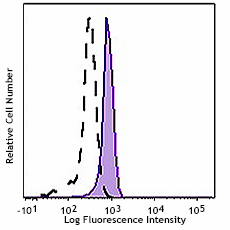
-

Human peripheral blood monocytes were treated with (filled histogram), or without (open histogram), Cell Activation Cocktail (Cat. No. 423301) for 15 minutes, fixed with Fixation Buffer (Cat. No. 420801), permeabilized with True-Phos™ Perm Buffer (Cat. No. 425401), then intracellularly stained with Human TruStain FcX™ (Cat. No. 422302), True-Stain Monocyte Blocker™ (Cat. No. 426103), anti-STAT3 Phospho (Ser727, clone A16089B) Brilliant Violet 421™.
| Cat # | Size | Price | Quantity Check Availability | ||
|---|---|---|---|---|---|
| 698915 | 25 tests | $182.00 | |||
| 698916 | 100 tests | $413.00 | |||
The STAT3 transcription factor is an important signaling molecule for many cytokines and growth factor receptors and is required for murine fetal development. STAT3 is an 88 kD member of the STAT (signal transducer and activators of transcription) protein family that is phosphorylated in response to a cytokine receptor-associated kinase activity. Stat3 is activated by phosphorylation at Tyr705, which induces dimerization, nuclear translocation, and DNA binding. Transcriptional activation was reported to be regulated by phosphorylation at Ser727 through the MAPK or mTOR pathways.
STAT3 forms both homo- and heterotrimers and is involved in the activation of genes required for cell growth and apoptosis. STAT3 is also involved in gp130 signaling and binds to IL-6 response elements in various acute phase protein promoters. STAT3 is phosphorylated by signaling from IFNs, EGF, FGF, IL-5, HGF, LIF, and BMP2. STAT3 activity is inhibited by PIAS3 and GRIM-19 and can also be regulated by the Rac1 protein.
Product Details
- Verified Reactivity
- Human
- Antibody Type
- Monoclonal
- Host Species
- Mouse
- Immunogen
- Human Stat3 peptide phosphorylated at Ser 727. Complete Freund's adjuvant.
- Formulation
- Phosphate-buffered solution, pH 7.2, containing 0.09% sodium azide and BSA (origin USA).
- Preparation
- The antibody was purified by affinity chromatography and conjugated with Brilliant Violet 421™ under optimal conditions.
- Concentration
- Lot-specific (to obtain lot-specific concentration and expiration, please enter the lot number in our Certificate of Analysis online tool.)
- Storage & Handling
- The antibody solution should be stored undiluted between 2°C and 8°C, and protected from prolonged exposure to light. Do not freeze.
- Application
-
ICFC - Quality tested
- Recommended Usage
-
Each lot of this antibody is quality control tested by intracellular flow cytometry using our True-Phos™ Perm Buffer in Whole Blood Protocol. For flow cytometric staining, the suggested use of this reagent is 5 µl per million cells in 100 µl staining volume or 5 µl per 100 µl of whole blood.
Brilliant Violet 421™ excites at 405 nm and emits at 421 nm. The standard bandpass filter 450/50 nm is recommended for detection. Brilliant Violet 421™ is a trademark of Sirigen Group Ltd.
Learn more about Brilliant Violet™.
This product is subject to proprietary rights of Sirigen Inc. and is made and sold under license from Sirigen Inc. The purchase of this product conveys to the buyer a non-transferable right to use the purchased product for research purposes only. This product may not be resold or incorporated in any manner into another product for resale. Any use for therapeutics or diagnostics is strictly prohibited. This product is covered by U.S. Patent(s), pending patent applications and foreign equivalents. - Excitation Laser
-
Violet Laser (405 nm)
- Application Notes
-
The STAT3 Phospho (Ser727) antibody recognizes the regulatory serine phosphorylation of human STAT3 protein.
- RRID
-
AB_2750261 (BioLegend Cat. No. 698915)
AB_2750261 (BioLegend Cat. No. 698916)
Antigen Details
- Structure
- STAT3 is a 770 amino acid protein of 88 kD. It consists of a DNA binding domain, a SH2 domain, a regulatory tyrosine responsible for binding of SH2 domain, and a C-terminal transactivation domain.
- Distribution
-
Ubiquitous
- Function
- STAT3 is also involved in gp130 signaling and binds to IL-6 response elements in various acute phase protein promoters. STAT3 is phosphorylated by signaling from IFNs, EGF, FGF, IL-5, HGF, LIF, and BMP2. STAT3 activity is inhibited by PIAS3 and GRIM-19 and can also be regulated by the Rac1 protein.
- Interaction
- When activated, STAT3 dimerizes and translocates to the nucleus where it regulates gene expression.
- Biology Area
- Cell Biology, Neuroscience, Neuroscience Cell Markers, Signal Transduction, Transcription Factors
- Molecular Family
- Nuclear Markers, Phospho-Proteins
- Antigen References
-
1. Akira S, et al. 1994. Cell. 77:63.
2. Zhang X, et al. 1995. Science 267:1990.
3. Sanchez-Margalet V, et al. 2001. Cell. Immunol. 211:30.
4. Simon A, et al. 2000. Science 290:144.
5. Hoey T, et al. 1999. Adv. Immunol. 71:145. - Gene ID
- 6774 View all products for this Gene ID
- UniProt
- View information about STAT3 Phospho Ser727 on UniProt.org
Other Formats
View All STAT3 Phospho Reagents Request Custom Conjugation| Description | Clone | Applications |
|---|---|---|
| PE anti-STAT3 Phospho (Ser727) | A16089B | ICFC |
| Purified anti-STAT3 Phospho (Ser727) | A16089B | ICFC,ICC,ChIP |
| PerCP/Cyanine5.5 anti-STAT3 Phospho (Ser727) | A16089B | ICFC |
| PE/Cyanine7 anti-STAT3 Phospho (Ser727) | A16089B | ICFC |
| Alexa Fluor® 488 anti-STAT3 Phospho (Ser727) | A16089B | ICFC |
| Brilliant Violet 421™ anti-STAT3 Phospho (Ser727) | A16089B | ICFC |
| Alexa Fluor® 647 anti-STAT3 Phospho (Ser727) | A16089B | ICFC |
Compare Data Across All Formats
This data display is provided for general comparisons between formats.
Your actual data may vary due to variations in samples, target cells, instruments and their settings, staining conditions, and other factors.
If you need assistance with selecting the best format contact our expert technical support team.
-
PE anti-STAT3 Phospho (Ser727)
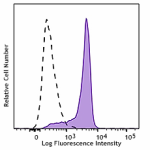
Human peripheral blood monocytes were treated with (filled h... -
Purified anti-STAT3 Phospho (Ser727)

Human peripheral blood monocytes were treated with (filled h... 
HeLa cells were fixed with 4% paraformaldehyde for 10 minute... 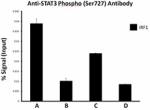
Chromatin Immunoprecipitation (ChIP) was performed using com... -
PerCP/Cyanine5.5 anti-STAT3 Phospho (Ser727)
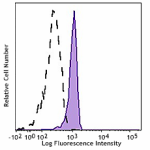
Human peripheral blood monocytes were treated with (filled h... -
PE/Cyanine7 anti-STAT3 Phospho (Ser727)
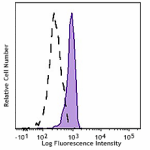
Human peripheral blood monocytes were treated with (filled h... -
Alexa Fluor® 488 anti-STAT3 Phospho (Ser727)
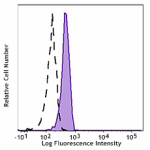
Human peripheral blood monocytes were treated with (filled h... -
Brilliant Violet 421™ anti-STAT3 Phospho (Ser727)
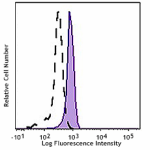
Human peripheral blood monocytes were treated with (filled h... -
Alexa Fluor® 647 anti-STAT3 Phospho (Ser727)
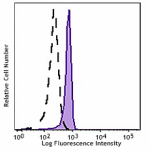
Human peripheral blood monocytes were treated with (filled h...
